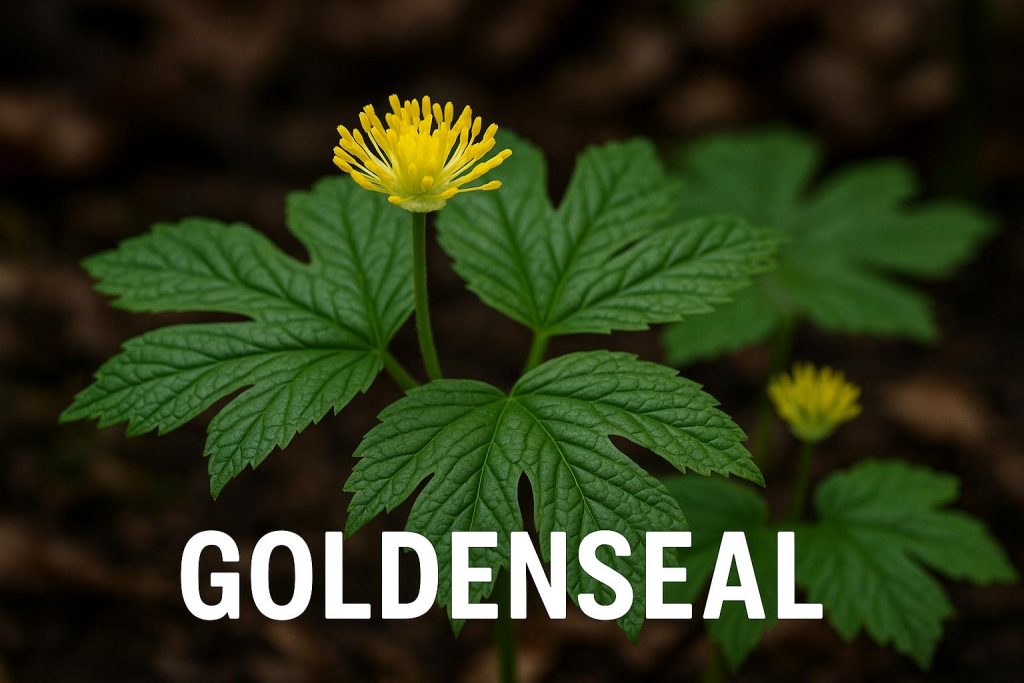
Overview of Goldenseal
Goldenseal (botanical name: Hydrastis canadensis) is a perennial herb traditionally valued for its potential therapeutic benefits. Originating from the eastern United States and southeastern Canada, this plant belongs to the buttercup family. Its most distinguishing feature is its thick, yellow knotted rootstock. Over time, Hydrastis canadensis has captured attention in both traditional and modern herbal medicine due to its purported medicinal properties.
Historical Usage
Goldenseal has a long history of use among Native American tribes who employed it as a remedy for various health concerns. From application in treating skin ailments to addressing digestive disorders, the herb played a significant role in indigenous medicine. Early European settlers quickly recognized its benefits, adopting and integrating goldenseal into their medicinal practices. Over the centuries, it continued to gain popularity, praised mainly for its antibacterial and anti-inflammatory features. This has positioned goldenseal as a staple in various herbal medicinal formulations.
Cultivation and Harvesting
The cultivation of goldenseal demands specific environmental conditions that mimic its natural habitat for optimal growth. It prospers under the canopy of shaded forests, thriving in rich, moist soil. These conditions support the plant through its growth cycle. As the demand for goldenseal increased, coupled with overharvesting, concerns arose concerning the sustainability of wild populations. In response, efforts have been made to encourage sustainable cultivation practices. This cultivation typically involves careful management of planting areas to maintain a balance with ecological concerns. The roots, or rhizomes, are primarily harvested in the autumn. During this time, they are believed to contain the most potent concentration of beneficial compounds.
Potential Health Benefits
The potential health benefits of goldenseal can be attributed to its chemical constituents, with berberine, hydrastine, and canadine being among the most notable. Berberine is especially recognized for its antimicrobial properties, which play a role in supporting gut health. It has been the subject of various studies aiming to unravel its potential in addressing microbial infections and promoting a healthy digestive system. Additionally, some preliminary research suggests goldenseal might support the immune system, although conclusive evidence is still lacking, necessitating further studies to corroborate these claims.
Precautions and Side Effects
Despite its widespread use, caution is advised when incorporating goldenseal into a health regimen, particularly due to potential side effects. Although many individuals use it without incident, some may encounter allergic reactions or gastrointestinal discomfort. Special groups, such as pregnant or breastfeeding women, are generally advised against using goldenseal due to limited research on its safety for these populations. Additionally, goldenseal may interact with certain medications, notably anticoagulants and antihypertensive drugs. Such interactions underscore the importance of consulting a healthcare provider prior to use, ensuring that it is safe and appropriate for individual health needs.
Given the complexity and potential of goldenseal in herbal medicine, further investigation into its applications could provide greater insight into its benefits and constraints. For those seeking detailed information on goldenseal, including nuanced discussions on its uses and safety, reputable resources like Healthline or Mayo Clinic offer comprehensive guidance and can serve as valuable starting points for both novices and practitioners in herbal medicine.
An In-Depth Look at Growth Conditions
Goldenseal’s cultivation does not solely focus on soil conditions and shade but also involves understanding the plant’s broader ecological requirements. As with many native understory plants, successful cultivation hinges on replicating the microenvironments where the plant naturally prospers. This includes careful attention to moisture levels, soil pH, and the biodiversity of the surrounding ecosystem. The provision of mulch and organic matter helps retain soil moisture and simulate forest floor conditions, facilitating healthier and more robust plant development. Cultivators aiming for high-quality goldenseal must consider these factors to avoid compromising the rhizome’s potency and potential therapeutic properties.
Varying Uses and Applications
Beyond traditional uses, goldenseal finds its way into a diverse range of applications today. Its extracts, combined with other herbs, appear in numerous over-the-counter preparations aimed at treating colds, respiratory infections, and skin conditions. Some formulations combine goldenseal with echinacea, purportedly enhancing the immune-boosting properties of both herbs. Additionally, it is employed in topical applications, capitalizing on its soothing properties for skin issues. Despite such diverse uses, it remains essential to approach these products with informed caution, acknowledging the absence of robust clinical trials backing many of the stated benefits.
Research Directions and Emerging Studies
Interest in goldenseal continues to incite new research, with scientists exploring its complex bioactive compounds and their implications further. Potential antifungal properties, impacts on blood sugar levels, and more profound insights into its influence on gut microbiota are among the current areas under investigation. As scientific techniques evolve, the ability to unravel the relationship between goldenseal’s traditional uses and its biochemical properties improves. Such advancements could herald the development of novel therapeutic agents derived from this historical herb.
The Conservation Aspect
The increasing popularity of goldenseal signifies a risk to its natural populations. Conservation efforts are indispensable, focusing not only on promoting sustainable harvesting but also on preserving the ecological niches essential for goldenseal’s continued survival. Strategies include establishing goldenseal as a part of conservation programs in botanical gardens and promoting practices like forest farming. This involves managed planting and harvesting processes designed to minimize environmental impact. By fostering an understanding of sustainable practices, both cultivators and consumers can contribute to goldenseal’s preservation while benefiting from its manifold potential applications.
In conclusion, goldenseal remains a plant of much interest across both historical and modern contexts. Its journey from indigenous remedy to a potentially invaluable modern-day dietary supplement illustrates the complex intersection of cultural practices and scientific inquiry. As research progresses, and sustainable practices take hold, goldenseal may secure its status not merely as a relic of herbal medicine history but as a vital component of future therapeutic strategies. Whether for its potential health benefits or its role in ecological and conservation discussions, goldenseal undoubtedly represents a significant subject warranting ongoing exploration and understanding.

